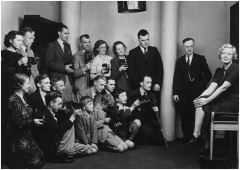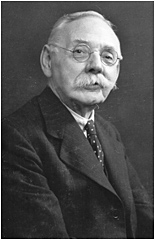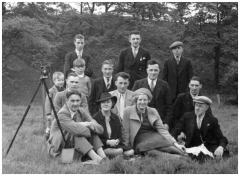The History of Atherton & District Amateur Photographic Society
Like all good ideas this one came from one man and seems to have stood the test of time, 75 years in fact. The visionary was Frank Pickford who in 1938 spoke to his friend Ernest Staveley about forming a local camera club in Atherton.
Frank had known E.O.Staveley most of his life as he was apprenticed to him at Gorton & Blackmore Engineers in Atherton. It was Ernest who introduced Frank to photography. He thought it would do no harm improving his drawing skills as they both worked in the drawing office. When Ernest left Gortons and started his own company, Staveleys Engineering, he took Frank and several others with him and the pair travelled around Britain working on jobs for the firm.
At the time there was only Leigh Literary Society photo section and Bolton Camera Club in the local area, so Frank, encouraged by Staveley, canvassed people local to Atherton about the idea of starting a photography society. He asked Tom Lee Syms, a professional photographer in Tyldesley, what he thought. Ernest had introduced him to Tom. He then placed an advertisement in the Leigh Journal asking interested people to a meeting at Church house Atherton on 4th April 1938 to float the idea.
Items on the meeting agenda included the executive, a possible meeting place, speakers and activities, membership fees and of course was it a viable proposal. Tom Lee Syms FRPS was elected President, F.E.Jones Vice President. John Burrows was poached from Leigh Literary Society as Treasurer, Frank Pickford was Secretary of the society and six committee members were elected.
The annual fee was set at five shillings. Meetings to be held every Thursday at 8pm. A possible meeting place was suggested at The Bears Paw public house and that all interested parties would be notified of progress. The suggested name was Atherton and Tyldesley Amateur Photographic Society, however this was changed to Atherton and District Amateur Photographic Society and our society was born
Our
ADAPS
Founders


The
First Meeting
April 21st
1938


The first meeting of ADAPS was held on 21st April 1938 in Church House, Atherton, and featured a talk by Charlie West, a Leigh photographer, on colour photography illustrated with colour lantern slides. On 5th May a talk by Tom Lee Syms on elementary photography was given, also at Church House. The club then found a home in the old tack room over the stables at the Wheatsheaf public house on Market Street in Atherton, and meetings commenced while the room was refurbished.
On Sunday 22nd May the first outdoor ramble was held to Borsdane Wood and the social side of the club was born. June 4th saw the club combining with Leigh Literary Society and Bolton Camera Club for a trip to White Coppice. On 1st August 1938 the club members met at T.L.Syms’ studio in Tyldesley and a club picture was taken, subsequently published in the Leigh Journal. In September ADAPS was at Liverpool docks on a trip organised by the Lancashire & Cheshire Photographic Union (L&CPU). In October 1938 Tom Lee Syms died and is buried with his family in Tyldesley Cemetary.
A full winter program followed culminating with the first Annual exhibition at Hesketh Fletcher School, Atherton. A small fee was charged to enter and the winners were F.E.Jones – T L Syms Memorial Trophy (Advanced prints), E.McGregor – Nichols Cup (Novice prints), John Burrows took the Portrait Certificate and other members the Colour and other sections of the competion. Presentations took place at Top Lane School, Atherton.
F.E. Jones was elected second President at the 1939 Annual General Meeting and the club became affiliated to the L&CPU. ADAPS continued to grow, while trying to improve the clubroom and facilities in the Wheatsheaf at the same time. The Second World War came along and things slowed up with members leaving to fight, the unavailability of materials and the general hardships of war. Some members could get hold of ex War Department materials and these were used to continue their hobby. By 1943 the club had 78 members. Comfort parcels were sent to ADAPS members on active service by the club. Sadly three members lost their lives and they are remembered on a plaque placed in the clubroom.
After the hostilities the club continued to meet at the Wheatsheaf and further improvements were made. Heating and lighting were upgraded, although relationships with the landlord seemed to be deteriorating. Access to the rooms was not considered very safe through the pub yard, there was minimal space to make a brew and toilet facilities left a lot to be desired. These problems continued for some years with the club looking for larger premises, but many happy hours were spent in the tack room.
In 1949 E.O.Staveley was elected the President,
a job in which he remained for 27 years.
In 1953 Frank Pickford emigrated to Canada to start a new life as a photographer, having worked as a freelance around the North West for some time.
Frank never lost touch with the club, visiting when he could and sending money over from Canada for the children’s Christmas parties and other special projects. He was elected President in 1978 after the death of Stavely and remained President and a member until 1982 when he died in Canada.
In November 1956 the Leigh Literary Society photographic section was wound up and gave ADAPS their exhibition screens and other bits of equipment that were of use. It was agreed that any member of Leigh Literary Society could transfer and become a member of ADAPS at no charge.
By August 1957 the club was having real problems with Mr Ratcliffe, landlord of the Wheatsheaf, who had already raised the rent on the room, then demanded that ADAPS have their own electric meter as the club drew power from the pub. The Electricity Board wanted ADAPS to rewire the rooms before the installation of a meter.
Things went from bad to worse by the end of 1957. Mr Radcliffe finally gave the club two weeks’ notice to quit the room in February 1958.
Frank Pickford Emigrates To Canada

Move To Our New Premises
New premises were already being sought some time before this. Rooms over the Co-op on Market Street were looked at, the purchase of an ex army hut from Bury Barracks was investigated but land would have been required. Even a possible move back to Church House was considered. Then a member suggested the old Band Room/School on Back Stanley Street.
An approach was made to the trustees of Atherton Temperance Band to share
their rooms and an agreement was reached to take over the paying of their debts for electricity and rates, with Atherton’s Arthur Higson joining the trustee of the Band Room on behalf of the club.The move was made in February 1958 taking ADAPS lock, stock, heating and barrel out of the Wheatsheaf to refurbish the Band Room, which had a single 60w light bulb for illumination, seats round the edge of the room and a pot bellied stove in the centre for heating. The room was also painted a very drab green. Work commenced to bring it up to standard with a new coat of paint, new lighting and heating and a partition across the rear of the room to make a better entrance, a lot of which was taken out of the old club room.
After some time sharing the room with the band who did not use it any more and with
the death of most of the trustees of the band, it was decided to purchase it by paying off the bands entire debts. Talks with Mr Eckersley Hope, who held the deeds for the building, took place and a figure was agreed of £225 in October 1960. The money was loaned by Ernest Staveley to be repaid at £5 a month interest free within two years provided trustees were appointed to oversee the club affairs, which were to include his daughter Miss K.Staveley.
The whole matter was put into the hands of a Liverpool solicitor and the society became property owners in April 1961. Fundraising then went into overdrive to repay the debt – calendars were made and sold, members purchased bricks in the clubroom at one shilling each and members were asked to loan the club £1. Lots of other ideas were tried and eventually a cheque for the outstanding amount was presented to Ernest, who then gave the money back to the club as a donation. Today, here we still are in Atherton, in our own room thanks to the efforts of those forward-thinking members.
Clubroom Improvements In 1960's & 70's
The club continued through the 1960s improving its facilities and by the end of
the decade it was decide to extend the rooms with a prefabricated building on the side,
to include a new kitchen, purpose built darkroom and, for the first time, internal toilets. Plans were drawn up and submitted to Atherton Council and approved in September 1971. Ground clearance got underway at the side. The gable end was rebuilt and a second-hand World War 2 concrete prefabricated building purchased in 1972. The building was subsequently erected by the members and our extended building put into use. Throughout the 1970s the club thrived, continuing to compete within the L&CPU with other societies, running its own interclub competition the Atherton Whole Plate competition.
In the 1980s ADAPS produced its own Newspaper ‘Focus’, running to ten issues over two years, reprised in 1992 for a Christmas special issue. This stopped not for lack of interest or contributors but the demise of one the editors and producer.
Over the years ADAPS has continued its tradition of annual exhibitions of members work in venues such as the Wheatsheaf Hotel, Hesketh Fletcher School, Church House Atherton, ADAPS own rooms and more recently Atherton Library, Tyldesley Library, Turnpike Gallery, Leigh, The History Shop in Wigan and as far afield as ViewPoint Gallery Salford. ADAPS has also combined with other photographic societies in the area for even bigger shows of work. ADAPS has always been proud to show its members work to people in the area and to encourage people into the rooms to learn to use their cameras. More recently we have been holding community evenings, inviting anyone to come in for a chat and a cake, perhaps to bring their cameras along and ask questions.
ADAPS has always been supportive of new developments in photography, accepting the new trade processed colour slides in the 1940s and in the 1990s commercially processed colour printing along with the L&CPU.
The Advent Of Digital

The 1990s saw a general decline in interest in photography and by the end of the millennium things at ADAPS were beginning to get a little desperate with membership down to about 20. Things took a dramatic upturn with the advent of digital imaging, which ADAPS was quick to embrace thanks to a few forward-thinking members, and now the membership is up to around 100 at times.
These days it is almost impossible to tell a digital image from silver print, with some very inventive work being done by the members in their electronic darkrooms. Who knows where photography will go in the future? 3D, Laser images, we don’t know… But we are sure that ADAPS will still be here encouraging members and teaching new techniques to both young and old as we have done for over 75 years.
Many thanks to Len Hudson, Archivist of Atherton & District Amateur Photographic Society
